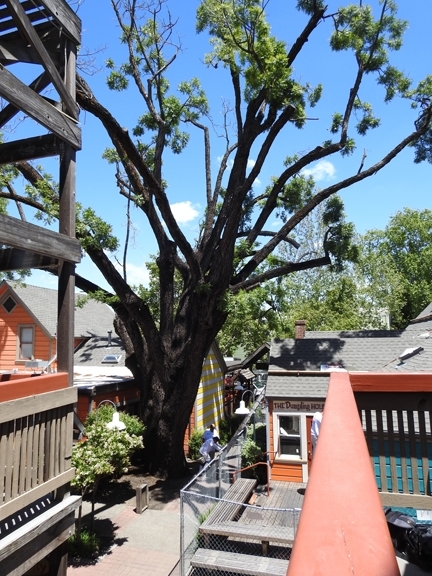
It's about 150 years old, 50 feet in height, and measures about five feet in diameter. And it's dying.
What's killing it is thousand cankers disease (TCD), an emerging insect-fungus complex.
It's killing a lot of black walnut trees.
In fact, TCD has caused profound damage to black walnut trees not only in urban areas of California and other western states, but in Pennsylvania, Tennessee and Virginia, according to a newly published review by UC Davis-affiliated scientists and their colleagues.
The article, “Status and Impact of Walnut Twig Beetle in Urban Forest, Orchard and Native Forest Ecosystems,” published in the Journal of Forestry, updates the spread of the disease, and chronicles the role of the bark beetle, Pityophthorus juglandis, and the canker-producing fungus, Geosmithia morbida, in killing walnut trees, especially black walnuts.
Native to southwestern United States and northern Mexico, the bark beetle, about half the size of a grain of rice, “has invaded urban, orchard and native forest habitats throughout the United States, as well as Italy,” said lead author and forest entomologist Steven Seybold of the Pacific Southwest Research Station, USDA Forest Service, Davis, and a lecturer and researcher with the UC Davis Department of Entomology and Nematology.
Walnut twig beetles (WTB) tunnel into branches and trunks of walnut (Juglans) where they create galleries for mating and reproduction. They carry spores of the fungus into their galleries, and the resulting fungal infection causes formation of cankers, which coalesce and girdle branches and stems.
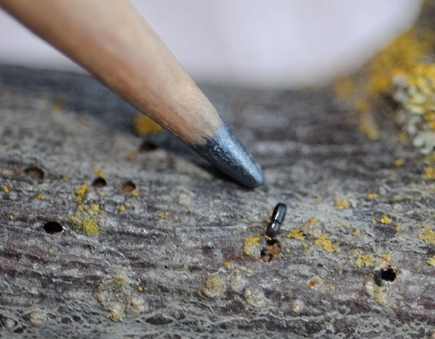
“The walnut twig beetle is a significant pest of very large trees because it sequentially attacks the small branches--though ironically not the twigs--all the way down the trunk to the soil line,” said Seybold, a pioneering scientist of TCD, who first found TCD evidence in Davis in 2008. “Most bark beetle species are not this thorough in using all of the phloem tissue in their plant hosts. In Davis right now, in the courtyard next to Sophia's Thai Restaurant, 129 E St, the tiny beetle is gradually killing the largest northern California black walnut tree in the city. It has taken nearly a decade, but the crown of the massive tree is nearly completed killed.”
Seybold estimated that the E Street tree is about 150 years old, "maybe older." It measures almost 65 inches or just over five feet.


Seybold noted that the disease is “unique because of its multifaceted negative impact on walnut trees involved in landscaping, food production, and forestry. Walnut trees are valuable ecologically and for food and timber, so the walnut twig beetle is a good model in which to study the impact of a bark beetle on forest and agro-ecosystem services.”
The five co-authors of the synthesis article include Stacy Hishinuma and Andrew Graves, two USDA forest entomologists with UC Davis connections. Hishinuma, who works in the Pacific Southwest Region, San Bernardino, and holds a doctorate in entomology from UC Davis, studied in the Seybold and Mary Lou Flint labs, UC Davis Department of Entomology and Nematology. Graves, who works in the Southwestern Region, Albuquerque, N.M., is a former postdoctoral fellow in the UC Davis Department of Plant Pathology.
Other co-authors are Professor William Klingeman III of the Department of Plant Sciences, University of Tennessee, and forest entomologist Tom Coleman with the USDA Forest Service's Southern Region, Asheville, N.C..
UC Davis doctoral student Jackson Audley of the Seybold lab and Richard Bostock lab (Plant Pathology), contributed photos of dead and dying walnut trees in the Davis area, along with UC Davis doctoral student Corwin Parker and Hishinuma. Audley, who is researching an ensemble of behavioral chemicals that repel the walnut twig beetle from landing on English walnut trees, conducts his research in a commercial orchard near Winters.
“WTB is one of a few invasive bark beetles in North America where expanding distribution and impact have been pronounced enough to affect other species, communities, and ecosystems to the extent that services provided by urban forests, agroecosystems, and wildland areas have been altered,” the co-authors concluded in their paper. “We envision that ecological impacts of WTB will continue to unfold across a wider geographic area to affect various types of key services, i.e., provisioning (e.g., timber and nontimber products); regulating (e.g., air and water quality/quantity, climate regulation); and cultural (e.g., recreation, aesthetics, shade) services.”
Scientists first collected the beetle in North America in 1896 in New Mexico, 1907 in Arizona, 1959 in California, and 1960 in Mexico, but never considered it a major pest of walnut trees until black walnuts began deteriorating and dying in New Mexico in the early 2000s. Walnut tree mortality that occurred in the early 1990s in the Wasatch Mountains of Utah and in the Willamette Valley of Oregon is now attributed to TCD.
“Currently, good cultural practices and sanitation of infested materials are the primary strategies for disease management within orchards and also for prevention of spread of the disease and vector to regions with low rates of infection,” according to the UC Statewide Integrated Pest Management Program (UC IPM)>
UC IPM recommends that trees with less than 50 percent live crown be removed to reduce the buildup of walnut twig beetles and inoculum in the trunk and larger scaffold branches. "Chemical control with either fungicides or insecticides is not recommended for management of thousand cankers disease," UC IPM says.
Which brings us back to the massive black walnut tree that is dying on E Street in Davis. If it dates back to 1868, that's the year the city of Davis was founded. Its namesake, Jerome C. Davis, owned a stock farm on the site.
Who was in the White House and who was in the California governor's mansion that year? Andrew Johnson and Henry Haight, respectively. That was also the year that trustees founded the University of California in Oakland; Clark Kerr became the first president. And 1868 was the year Memorial Day was first observed in the United States...and when author Louisa May Alcott published the first volume of her coming-of-age novel, Little Women.
The little tree in Davis became of age, too, growing into a giant tree offering shade, shelter and sustenance. Who would have thought that a tiny insect, half the size of a grain of rice, would play a major role in its demise?
Attached Images:
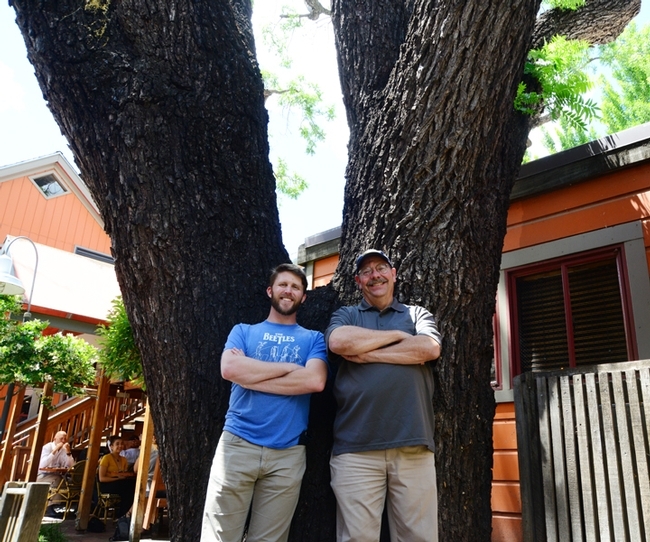
Forest entomologists Steve Seybold (right) and Jackson Audley stand by a 150-year-old black walnut tree on the 100 block of E Street. It is dying of thousand cankers disease. (Photo by Kathy Keatley Garvey)
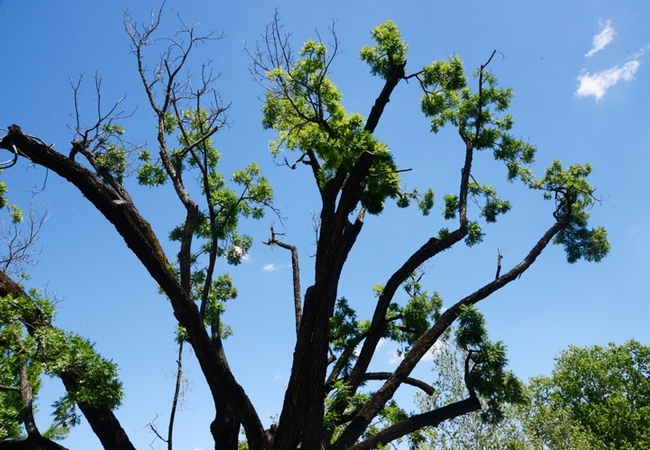
Walnut twig beetles tunnel into branches and trunks of walnut (Juglans) where they create galleries for mating and reproduction. In association with a canker producing fungus, Tthey cause a disease known as thousand cankers disease. This tree is in downtown Davis, Calif. (Photo by Kathy Keatley Garvey)
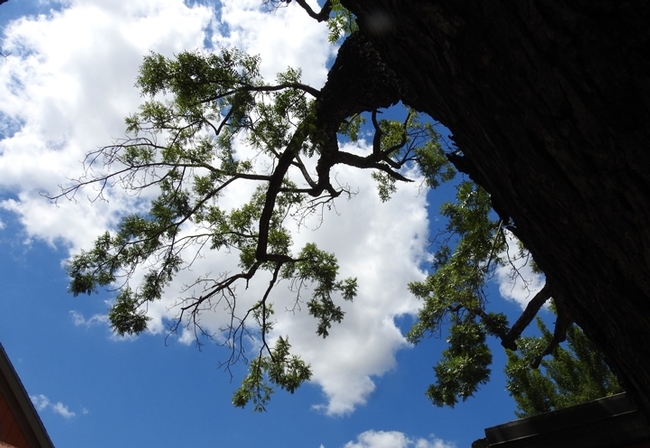
This massive, 150-year-old black walnut tree on the 100 block of E Street, Davis, is dying of thousand cankers disease. (Photo by Kathy Keatley Garvey)